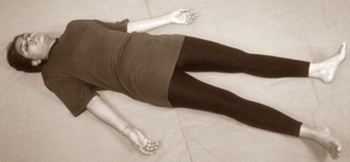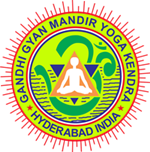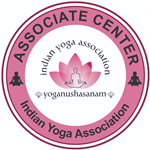
Yoga Nidra is an ancient Indian Yogic method for providing complete rest to body and mind. Yoga sleep was ignored for centuries and it reached the edge of extinction. At this juncture many great yogis and especially Paramahansa Swami Satyanand Saraswati, the founder of Bihar School of Yoga have brought it back to the knowledge of thousands. Since then many are being benefited.
The Swamiji visited Gandhi Gyan Mandir Yoga Kendra, Hyderabad 5 times and taught this process to the aspirants. After conducting further research on it and performing it practically, certain minor changes have been made to suit to the modern period. It is expected that the Yoga practitioners will learn this wonderful activity and get benefited.
Yoga Nidra is the elaborate extension of Shanti asan.
Process:
Lying in Shanti asan, the mind is concentrated on normal breathing. Slowly all the thoughts are given up. All the major and minor parts of the body are visualized i.e., mentally viewed, their shapes are recalled and let loose one after the other continuously in the following sequence:
Right hand:
Thumb➙ fore finger➙middle finger➙ring finger➙little finger➙back of the palm➙the palm➙wrist➙fore arm➙elbow➙upper arm➙shoulder➙
Right leg:
Big toe➙second toe➙third toe➙fourth toe➙little toe➙the upper part of the foot➙sole ➙heel➙ankle➙calf➙knee➙ ➙thigh➙thigh joint➙
Left leg:
As in right leg➙
Left hand:
As in right hand➙
Back:
From the bottom of the backbone to the neck➙the right side of the back➙the back of the right shoulder➙the left side of the back➙the back of the left shoulder➙the back of the neck➙
Abdomen, chest and throat:
Navel➙the left side of the navel➙lower side of the navel (including the urinary organ)➙the right side of the navel➙the upper side of the navel➙ the central part of the chest➙right breast➙left breast➙the pit below in the throat➙throat➙
Head:
Chin➙lower lip➙tongue➙upper lip➙right nostril➙right cheek➙right ear➙ right eye➙left eye➙left ear➙left cheek➙left nostril➙tip of the nose➙the center of the eye brows➙forehead➙right side of the head➙back of the head➙left side of the head➙top of the head.
Each above said part of the body, in the above said order, should be concentrated upon for about 10 to 20 seconds. The shape should be visualized by the mind with closed eyes. While looking so, the concerned spot should be freely let loose.
The entire process may be completed in about 15 to 30 minutes. This is called one round. More rounds may be practiced according to the choice and necessity of the aspirant (sadhak).
With regular practice, the sadhak will then be able to not only loosen the outer areas but will also succeed to loosen and relax the depths of the body.
It is better to practice this on the bed itself as preliminary step for sleep. This helps in getting peaceful sound sleep. Mind and body get complete rest. They are totally relaxed. As the quality of sleep improves, sleeping duration is also reduced. The time is saved, which can be utilized for Yoga Sadhana.
During Yoga Nidra practice, the following feeling may generate:
1. The body seems to be either heavy or light……
2. On some parts of the body, we feel like having burning sensation or cooling sensation……
3. We feel as if either some insects creeping on or biting it or pulling it up or shivering on our skin……
4. The body feels as if, either it is flying in the sky or floating in an ocean or being pressed deep in the earth……
5. The tongue feels some taste, ears listen some sound, nose smells some fragrance, closed eyes feel the glow of lights……
6. Some areas of skin feel the touch of either hot air or cool breeze……
7. Though the breath is normal, still it is felt either running with great speed or going to stand still……
Similar to above, the practitioner may have, some other temporary feelings also. Inspite of such distractions, the practitioner should not deviate his concentration.
As these feelings may be for few seconds only and so one should try to continue the process without moving the body at all. (Certain movements of body will be happening without control – like due to breathing, heart beats, blood circulations, digestion etc., one should not worry about such and should not be disturbed at all).
Advantages:
1. Every person meets many people everyday. Similarly in Yoga Nidra the practitioner meets his own self-part by part.
2. The practitioner gets sound sleep. Time is not wasted in waiting for sleep.
3. The tiredness of the body is relieved. Though the sleeping time is reduced by the sound sleep, all the parts of the body are relaxed to their maximum and they are re-charged with energy.
4. Tension, anxiety, depression, stress, strain, negative thoughts, high blood pressure etc. are controlled.
5. The practitioner feels physically stable and mentally peaceful. The instability in the behavior is controlled.
6. Psychological problems especially in women are prevented.
7. Memory, will power and inner energies are developed and so it is an important aid to students.
8. The sadhak becomes introvert. Knowledge is developed.
9. Regular practice of Yoga Nidra plays a big role in the higher practices of concentration, meditation and self-realization.
![]()
Yoga Nidra is a delicate micro process. Therefore the mind should be completely sub-merged in the exercise. In the initial stage it should be practiced either under the guidance of Yoga experts or alternatively listening to our specially recorded audio cassets/VCDs/DVDs.
![]()

